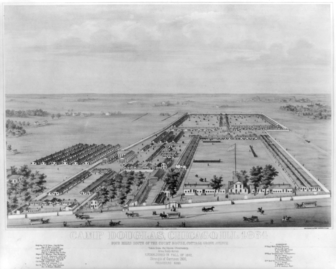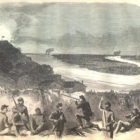THREE YEARS IN THE CONFEDERATE SERVICE: Chapter IV
THREE YEARS IN THE CONFEDERATE SERVICE:
Chapter IV
Upon its arrival at Vicksburg, the First Alabama Regiment was quartered in the public-school building, where they remained several days. The city, even then, bore marks of the havoc of war. Shot and shell had torn huge rents in the walls of the houses, and ploughed up or dug great holes in which could have been buried a horse and cart. On the bluffs, and along the water-front, were batteries of heavy artillery, and soldiers were everywhere. Such an air of desolation pervaded the city that it was a relief to be ordered away. Two days after our

arrival, on September 24th, A. P. Brown died of disease contracted at Camp Douglas. W. A. Dennis, who also returned sick, was sent to the hospital at Lauderdale Springs, where he died October 10th. On Saturday, September 27th, the regiment took the cars for Jackson, and, arriving there about noon, marched four miles out of the city, and went into camp near the Sweet Water Church. Here it remained till Wednesday, October 1st, when orders were received to proceed to Port Hudson. The regiment went by rail to Tangipahoa, La., and thence marched 33 miles to Clinton, arriving on the morning of October 4th. The rest of the journey (20 miles) was made via the Clinton and Port Hudson Railroad. This road was not first-class, either in road-bed or equipment flat rails, on rotten stringers and ties, one locomotive, one passenger car and half a dozen platform and box cars. Only half of our regiment could be transported at one trip; and, as it was the rule to run off the track at certain points, night had fallen before the two trips were made. The regiment encamped on the bluff in the rear of Battery No. 1 (afterwards Battery 2), between the village and depot.
CAPT. ISBELL AND HIS BATTALION
After the surrender of Island No. 10, those who escaped, and others absent on leave, were collected at Fort Pillow and organized into three companies, under the command of Capt. R. H. Isbell. In this battalion there were the following members of Co. K : Lieut. M. E. Pratt, O. S. Norman Cameron, Corp. W. L. Ellis, Privates E. L. Averheart, Josiah Durden, John Griffin, E. Hearn, G. Hearn, W. H. Hutchinson, Junius Robinson and G. H. Royals. The battalion was attached to Gen. Villipigues brigade; and soon after its organization was ordered to Grenada, Miss., where it remained some ten days doing provost duty. Thence it was ordered to North Mississippi to meet a raid of the Federal cavalry, but the enemy retired before its arrival. The summer months were spent in camp at Abbeville and Cold Water.
BATTLE OF CORINTH
Late in September, Gen. Villipigues brigade, including Capt. Isbells battalion, was ordered to join Gen. Van Dorn. The brigade arrived at Corinth, and was attached to Lovells division, forming a part of the right of the army. The first days fight (October 3d) resulted favor ably to the Confederates. On the second day it was planned that Gen. Price should attack in force on the left, and that, while thus engaged, Lovells division should press forward and attack vigorously on the right. The attack was unfortunately delayed by the failure of Gen. Herbert to advance till 8, a. m., giving Gen. Rosecrans time to bring up fresh troops. Price drove the enemy before him, and penetrated into the streets of the town. Here his thinned brigades were attacked by the fresh troops of the enemy, and driven in disorder back over the ground they had won. Lovell, in the mean time, was advancing in pursuance of his orders, but had not yet engaged the enemy, when he received orders to throw Villipigues brigade rapidly to the centre to cover the retreat of Prices broken ranks. This was gallantly done; and if Capt. Isbells men had no opportunity to win laurels in the battle, they won a glorious meed of praise as a portion of the rear-guard in covering the retreat. So well was the duty performed that Rosecrans did not attack, and Gen. Van Dorn retired in safety. The only serious molestation was a skirmish at the Hatchie Bridge. After the retreat of the army to Oxford, Gen. Villipigues brigade was ordered to Port Hudson, where it arrived November 5th.
THE REUNITED REGIMENT
There was great rejoicing in the reunited company and regiment.
Gen. Villipigue died soon after his arrival (Nov. 9th), of cholera morbus, and his remains were sent to Richmond for interment, Corp. Ellis, of Co. K, being one of the escort.
The regiment now numbered nearly 700 muskets, having lost about 150 men since leaving Pensacola. Capt. Isbells battalion brought with it a brass band; and, as the regiment was by this time fairly well drilled, it made a good military appearance on parade. The citizens of Mobile had presented the regiment with a uniform on its return from prison. Its guns, though in good order, were of a nondescript character rifles, Springfield muskets, altered flint-locks and flint-locks; Co. K, being last on the list, had to put up with flint-locks. All the guns were, however, provided with bayonets, which gave them a uniform appearance. The men were in excellent spirits and condition. On the arrival of the regiment in October Cos. A, B and G were assigned to batteries, and on December 31st Co. K was assigned to a battery to be constructed.
Capt. Whitfield, who received a furlough after his exchange, arrived at Port Hudson on November 8th; Lieut. Pratt, on November 17th; and Lieut. Hall, who was furloughed at Jackson, December 5th.
ARRIVAL AT PORT HUDSON
Port Hudson is in East Feliciana parish, La., on the east bank of the Mississippi River, 25 miles above Baton Rouge. Before the war it was a place of considerable activity; about 30,000 bales of cotton and 2,000 hogs heads of sugar were shipped there annually; there were twelve or fifteen stores, and a population of some three hundred. The bluff is very high nearly 80 feet above low water. At the time of the arrival of the First Alabama, there were fourteen or fifteen guns mounted, varying in size from 24-pounder siege guns to 8-inch shell guns, and one 10-inch Columbiad. During the following winter and spring several batteries were constructed and additional guns mounted, so that at the beginning of the siege, in May, 1863, the batteries and guns were as follows:
PORT HUDSON LAND DEFENCES

Battery No. 1 (signal battery)Co. K, First Alabama, one 30-pounder Parrott, calibre 4 x% inches, siege carriage; one 20-pounder rifle (brass), calibre 4^ inches, siege carriage.
Battery No. 2Co. A, First Alabama, one 42-pounder, smooth-bore,barbette carriage; one rifle (old 24-pounder, smooth-bore rifled, but not strengthened), barbette car riage ; one ditto, siege carriage.
Battery No. 3Co. G, First Alabama, one smooth-bore, 42-pounder; one rifle, calibre 6 inches (old 32-pounder), both mounted on barbette carriages.
Battery No. 4De Gournays battalion, one 10-inch Columbiad and one 8-inch Columbiad, Columbiad car riages.
Battery No. 5Co. B, First Alabama, one 10-inch Columbiad, Columbiad carriage; one 32-pounder, bar bette carriage.
Battery No. 6De Gournays battalion, one rifle (old 32-pounder); one rifle (old 24-pounder).
Battery No. 7Tennessee company attached to De Gournays battalion, hot-shot battery, two 24-pounders.
Batteries Nos. 8 and 9De Gournays battalion, each one 24-pounder, siege carriages, water batteries.
Battery No. 10De Gournays battalion, one 8-inch shell-gun, barbette carriage, water battery.
Battery No. 11Miles legion, one 20-pounder Parrott, extreme right of the land defenses.
The batteries were nearly all provided with bomb-proof magazines, but with no protection for the men except the low parapet. From Battery No. 1 to 11 it was a little over one mile.
A system of land defenses had been planned, and work slowly progressed during the winter of 1862-3. The full plans of the engineers were never carried out, and at the commencement of the siege the works on the northern side had not been begun. As planned the defenses began at Battery No. 11 and extended in a semi-circular direction for a distance of over four miles, striking the river near the mouth of Sandy Creek, about one mile above Battery No. 1. The earth-works, where completed, consisted of a cremaillere line, broken by occasional lunettes and redans for artillery. Where the ground was open and favorable to assault, the ditch was from three to four feet deep and five or six feet wide. From the bot tom of the ditch to the top of the parapet it was, in no case, more than seven or eight feet, except when in creased by the natural features of the ground, as in front of Battery No. n, where there was a deep ravine. In Northern publications, maps are given showing a very complete system of defenses, with inner and outer lines, but these, if planned, were not constructed there being but a single line of works, except that during the siege inner lines were constructed across points mined by the enemy, as at the northeast angle and Battery No. 11.
RED RIVER SUPPLIES
During the autumn and winter of 1862-3 communication was open between Vicksburg and Port Hudson, and both places were supplied with provisions from the Red River country. Transports arrived quite regularly from Red River at Port Hudson, until interrupted by the blockade established by Farragut in March, 1863. Cattle were driven from Texas for the use of the garrison; great herds of long-horned oxen swimming the Mississippi, was a curious but not uncommon sight. The cattle arrived in very good condition, but as there was but poor pasturage at Port Hudson some became skeletonized before they were slaughtered.
The commissariat during the six months preceding the siege was generally good. Plentiful rations of corn meal, beef, sugar, molasses and salt were issued, and sometimes potatoes. Some extras could also be purchased in the surrounding country, while the river and cypress ponds furnished fish.
The cooking was done in camp, the messes detailing some of their own number or hiring negro cooks. Ladies from the neighborhood quite frequently visited camp and showed much interest in the culinary department. A motherly old lady, on one occasion, after watching the movements of one of Co. Ks cooks for some time, told the amateur, who had felt somewhat complimented by the attention, that she thought it would improve his kettles if he would burn them out. It is needless to say that he took the first opportunity of getting rid of the surplus soot and grease on his cooking utensils by following the advice.
